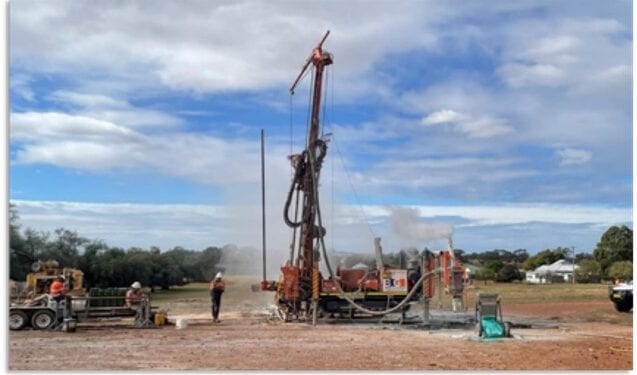Significant Shallow Gold Defined At Goodwood Reef
Krakatoa Resources Limited (ASX: KTA) has confirmed a new gold discovery with initial assay results from the maiden RC drilling programme completed over the Bulgandry Goldfields, within its 100% owned Rand Gold Project in NSW, Australia.
The Project is centred approximately 60km NNW of Albury in southern NSW covering 580 sq. km of an under-explored part of the well-endowed Lachlan Fold Belt.
CEO, Mark Major, said the reconnaissance RC drill programme was designed as a broad, first-pass test of a small selection of known historical mine workings within the Bulgandry Goldfields. Nine reverse circulation (RC) holes were drilled totalling 1,275m.
Eight tested for widths and gold grades beneath surface workings and one hole tested a new zone of veins mapped and sampled by KTA in 2021. All initial composite samples were fast tracked by the laboratory and assay results from the programme have now been received.
The assay results have identified significant shallow gold mineralisation.
Best results include: 40m @ 0.22g/t Au from 60m, including 12m @ 0.52g/t and 2m @ 1.14g/t, and 8m @ 0.75g/t Au from 46m, including 5m @ 1.13g/t
“We are excited to have completed our maiden RC drilling program at the Bulgandry Goldfields, the first drilling to have been undertaken over several of the historical yielding, high grade gold mines,” Mr Major said.
“It is great to see strong gold results generated from our first ever reconnaissance drilling which has also confirmed widespread IRGS-style gold mineralisation outside the known areas.
“It’s very pleasing that we have successfully intersected several zones of shallow gold mineralisation at the Goodwood Reef Mine, a location that has never been previously tested by drilling due to historic land access issues.
“Again, these initial results demonstrate that this area has the hallmarks of a large system with multiple parallel lodes. We are just starting to touch the surface of our knowledge on this area and its systems.
“The company is currently awaiting final assays from the regional scale auger soil geochemical survey and the reconnaissance air-core drilling program over the magnetic bullseye targets area.
“We look forward to sharing strong news flow over the coming months from this emerging greenfield exploration. These results will enable us to plan the next phase of our systematic exploration strategy.”
Mr Major said first phase drilling has provided new, quality geological data that will help KTA understand the bigger picture, the rock types, and controls on gold mineralisation. Surface outcrop observations, geochemistry and the drilling results collectively suggest the presence of several vein generations of varying mineralisation.
At least seven of the nine recent holes intersected hornfels (silica-magnetite±pyrite altered metasediments and foliated cordierite “schists”, i.e. contact metamorphism) implying that the workings are proximal to intrusives. The large angular body underplating the centre of the tenement is now interpreted to be a granitic body that outcrops immediately south of, and 500 metres northwest of the Show Day Mine.
The current, early hypothesis is that Bulgandry may fall within the “Plutonic” Zone of Morrison’s IRGS model verging on the “Porphyry” Zone. The current scale of the target area, favourable geological setting masked by cover, and the tenor of the geochemical results being generated in this early phase of exploration exhibits the significant potential of a large-scale system still yet to be uncovered.












